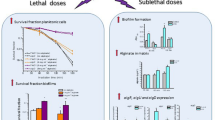Abstract
The responses of Gracilaria lemaneiformis, an easily epiphytized host,and the relatively resistant G. cornea mutant, to the green alga Ulva lactuca were studied using biculture experiments with and withoutantibiotics. Both Gracilaria species grown with and without U.lactuca showed different levels of growth rate, release of hydrogenperoxide and of halogenated hydrocarbons. These quantitative differencesled to a successful response against Ulva lactuca in the case of G.cornea mutant and to a failure in response in the case of G.lemaneiformis. The response of each Gracilaria species to U.lactuca was qualitatively similar to its response to bacteria. This suggeststhe involvement of oligosaccharide elicitors produced in the presence ofepiphytes and bacteria. A clear Gracilaria inhibition was demonstratedwith extracts of the culture medium. It appears that hydrogen peroxide,halogenated hydrocarbons and oligosaccharides may be components of theinhibitory activity of the extracts. The responses of Gracilaria speciesto the presence of U. lactuca suggest the characterization of adefence response.
Similar content being viewed by others
References
Bouarab K, Potin P, Correa J, Kloareg B (1999) Sulfated oligosaccharides mediate the interaction between a marine red alga and its green algal pathogenic endophyte. The Plant Cell 11: 1635-1650.
Buschmann AH, Kuschel FA (1988) Cultivo intermareal de Gracilaria sp: Colonizacion de esporas e interacciones con Ulva lactuca. Biota (Chile) 4: 107-113.
Callow JA (1984) Cellular and molecular recognition between plants and fungal pathogens. In Linskens HF, Heslop-Harrison J (eds), Encyclopedia of Plant Physiology 17. Springer-Verlag, Berlin, Germany, pp. 212-237.
Collen J, Del Rio MJ, Garcia-Reina G, Pedersen M (1995) Photosynthetic production of hydrogen peroxide by Ulva rigida. Planta 196: 225-230.
Davis AR, Targett NM, McConell OJ, Young CM (1989) Epibiosis of marine algae and benthic invertebrates: natural products chemistry and other mechanisms inhibiting settlement and growth. In Scheuer PJ (ed.), Bioorganic Marine Chemistry. Springer, Berlin.
Dawes CJ, Teasdale BW, Friedlander M (2000) Cell wall structure of the agarophyte Gracilaria tikvahiae and G. cornea and penetration by the epiphyte Ulva lactuca. J. appl. Phycol. 12: 567-575.
Dixon RA, Lamb CJ (1990) Molecular communication in interactions between plants and microbial pathogens. Annu. Rev. Plant Physiol. Plant mol. Biol. 41: 339-367.
Doke N, Tomyama K, Furuichi N (1982) Elicitation and suppression of the hypersensitive response in host-parasite specificity. In Asada Y et al. (eds), The Physiological and Biochemical Basis of Plant Diseases. Japan Scientific Societies Press, Tokyo, Japan, pp. 79-96.
Evans LV (1981) Marine algae and fouling: A review, with particular reference to ship fouling. Bot. mar. 24: 167-171.
Friedlander M (1992) Gracilaria conferta and its epiphytes: the effect of culture conditions on growth. Bot. mar. 35: 423-428.
Friedlander M, Gonen Y, Kashman Y, Beer S (1996) Gracilaria conferta and its epiphytes: 3. Allelopathic inhibition of the red seaweed by Ulva cf. lactuca. J. appl. Phycol. 8: 21-25.
Kombrink E, Somssich IE (1995) Defense Responses of Plants to Pathogens. Adv. Bot. Res. 21: 1-34.
Kupchan SM, Komada Y, Branfman AR, Sneden AT, Court WA, Thomas GJ, Hintz HPJ, Smith RM, Karim A, Howie GA, Verma AK, Nagao Y, Dailey RG, Jr, Zimmerly VA, Summer WC, Jr (1977) The maytansinoids. Isolation, structural elucidation, and chemical interrelation of novel ansa macrolides. J. org. Chem. 42: 2349-2357.
Levy I, Friedlander M (1994) Seasonal growth activity of local and foreign gracilarioid strains in Israel. J. appl. Phycol. 6: 447-454.
Miller WL, Kester DR (1988) Hydrogen peroxide measurement in seawater by (p-Hydroxyphenyl) acetic acid dimerisation. Anal. Chem. 60: 2711-2715.
Mtolera MSP, Collin J, Pedersen M, Ekdahl A, Abrahamsson K, Semesi AK (1996) Stress-induced production of volatile halogenated organic compounds in Eucheuma denticulatum (Rhodophyta) caused by elevated pH and high light intensities. Eur. J. Phycol. 31: 89-95.
Pedersen M, Collen J, Abrahamsson K, Ekdahl A (1996) Production of halocarbons from seaweeds: an oxidative stress reaction? Sci. Mar. Barc. 60: 257-263.
Potin P, Bouarab K, Kuepper F, Kloareg B (1999) Oligosaccharide recognition signals and defence reactions in marine plant: microbe interactions. Curr. Opinion in Microb. 2: 276-283.
Svirski E, Beer S, Friedlander M (1993) Gracilaria conferta and its epiphytes: 2. Interrelationship between the red seaweed and Ulva cf. lactuca. Hydrobiologia 260/261: 391-396.
Weinberger F, Friedlander M (2000a) Endogenous and exogenous elicitors of a hypersensitive response in G. conferta. J. appl. Phycol. 12: 139-145.
Weinberger F, Friedlander M (2000b) Response of Gracilaria conferta to oligoagars results in defense against agar degrading epiphytes. J. Phycol. 36: 1079-1086.
Weinberger F, Friedlander M, Hoppe H-G (1999) Oligoagars elicit a physiological response in Gracilaria conferta (Rhodophyta). J. Phycol. 35: 747-755.
Weinberger F, Hoppe H-G, Friedlander M (1997) Bacterial induction and inhibition of a fast necrotic response in Gracilaria conferta. J. appl. Phycol. 9: 277-285.
Wever R, Tromp MGM, Krenn BE, Marjani A, van Tol M (1991) Brominating activity of the seaweed Ascophyllum nodosum: impact on the biosphere. Environ. Sci. Technol. 25: 446-449.
Author information
Authors and Affiliations
Rights and permissions
About this article
Cite this article
Friedlander, M., Kashman, Y., Weinberger, F. et al. Gracilaria and its epiphytes: 4. The response of two Gracilaria species to Ulva lactuca in a bacteria-limited environment. Journal of Applied Phycology 13, 501–507 (2001). https://doi.org/10.1023/A:1012593400901
Issue Date:
DOI: https://doi.org/10.1023/A:1012593400901



